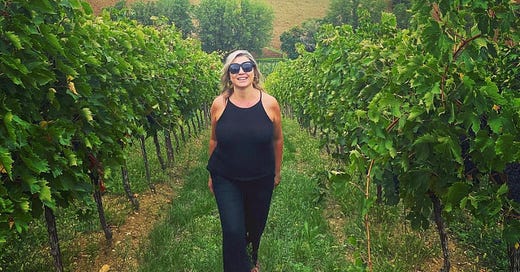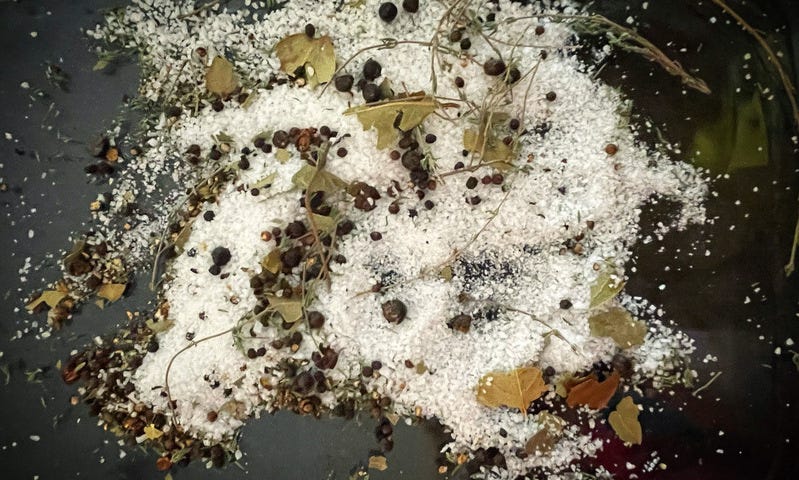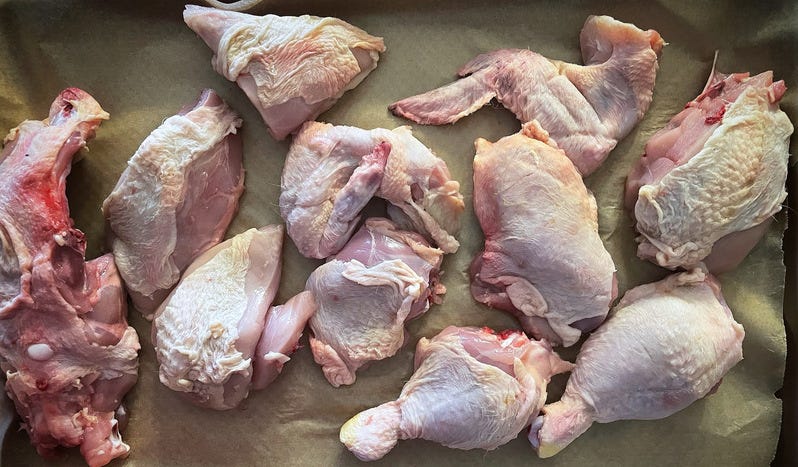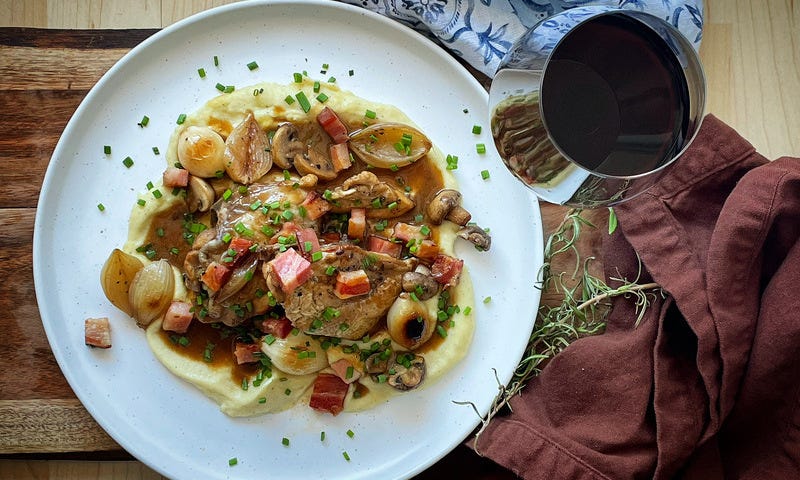Quaintrelle Coq au Vin
Make-ahead, slow cooked and reasonably easy, this is one of my favourite dinner party meals.
It’s been harder than I thought, separating my newsletter, this newsletter, Quaintrelle, from the one of the company I own.
I started The Wine Sisters 12 years ago (or thereabouts. A little-known fact is I had been dreaming up TWS for years before starting out, and when I did put the wheels in very slow motion, I was still working for someone else. I think our business licence says 2010, but I feel like we didn’t really hang the shingle out until 2011. Business didn’t really start flowing until 2012. So TWS started either 14, 13, or 12 years ago.)
Either way, like I mentioned in the most recent TWS newsletter, I am The Wine Sisters, and The Wine Sisters is me. We’re one and the same. It’s a co-dependent relationship I find comforting and easy, but the time has come to extricate myself from my company. Or extricate it from me.
It’s the only way either of us will grow.
So welcome to the world of Quaintrelle. Think of this space as your weekly dinner party.
Each week, I will send you ideas for easy(ish), make ahead (mostly), meals to impress a crowd, snappy cocktails to celebrate the season, recommendations for wine pairings and bottles I have just discovered, and interesting things I have stumbled upon from cookbooks both old and new, to linen napkins, to amazing shops with the best deals on interesting ingredients. And if I discover a fool-proof way to keep your tulips fresher for longer or easy ways to get the mysterious, post-party stain out of the couch, I will share it here, too.
Basically, anything and everything that surrounds throwing a terrific bash – the lead up, the roll out, and the clean-up.
This newsletter is Quaintrelle’s maiden voyage. Let’s get on with it.
Coq au Vin for the Ages
The evolution of a sophisticated dinner party.
The very first “fancy” recipe I ever cooked was coq au vin. (Scroll to the bottom for the recipe. But keep reading for the entertaining backstory.)
It wasn’t the first “thing” I ever cooked. I had started cooking in my early 20’s – including an ambitious, vegetarian, Thanksgiving dinner for my sister, boyfriend, and cousin when my parents buggered off on a cruise and left us holiday orphans. But the dishes I had made up until the Dinner of the Coq au Vin, while perhaps zealous for my skill level, were mostly moderate in their results.
After a few years of a few hits and a lot of misses, the time had come for a call up to the big leagues of coq au vin. This is a standout recipe for me, because, it is, to use a turn of phrase, the recipe that launched a thousand dinners.
I was 27, a television news reporter and fill-in anchor for the local arm of a national network and dating the (then) love of my life. I thought it would be very chic of me to make dinner for my beau and my parents. How grown-up. I was absolutely thrilled at the idea of my first, civilized dinner party. I believe it involved cloth napkins.

Quick Coq au Vin, the recipe found on page 16 of the circa 2003 specialty publication, The Best of Cooking Light: Simple Suppers, promised I could get six, 230-calorie servings, on the table in 27 minutes.
(I still have that tattered magazine, now naked and frail, the cover having ripped off long ago; the pages loosely held together by ever-weakening staples. The recipes are slightly cringe-worthy in their early aughts fashion of low-calorie and fat-free offerings, but it still holds a place of high respect and reverence for me as the starting point to my serious cooking adventures.)
I remember that quick coq au vin being pretty good. Impressive, even. As a cub home cook, it took me closer to an hour to fumble my way through the kitchen, but still a decent showing. There were cloth napkins, there was candlelight.
Cooking Light’s simple, 11-ingredient coq au vin stayed in my repertoire for years, slowly changing along the way. As my confidence grew, and better ingredients became readily available, the dried thyme the CL recipe called for was swapped out for a bundle of fresh. I almost immediately did away with the prescribed dredging my chicken thighs in flour, instead adding it to the sauce. I also use white wine instead of red, preferring both the taste and the aesthetic, technically making this coq au vin blanc. And when I learned Julia Child fired hers up with a shot of cognac, I did the same (once I figured out what cognac was and got over the sticker shock of the exorbitant pricing. Brandy, incidentally, does just as well.)
Because my life, and my cooking skills, aren’t static, my recipes naturally morph. Sometimes barely noticeable from the original, sometimes the before-and-afters look nothing alike. There are some things I make that are nearly cast in amber – my German mum’s braised red cabbage, our family’s potato salad that everyone loves, and my sister would kill me if I gave away the recipe. But other than a few deeply entrenched family favourites, everything else is up for evolution.
And so quick coq au vin, has become considerably longer coq au vin, a soothing and rhythmic kitchen project for a grey, Sunday afternoon. I cut up a whole chicken in the morning, submerge the pieces in white wine until the late afternoon, when I begin cooking.
This is a long recipe, but really, quite a straightforward one. If you are someone who panics at the sight of more than 10 ingredients or stops reading upon the discovery that recipes will that take an hour or more, I encourage you to keep going. This is mostly hands off, and the ingredients are humble. In fact, the initial mirepoix of carrot, onion, and celery can be simply scrubbed and roughly chopped, no peeling necessary, as they’re only used to flavour the sauce and discarded later.
Pour a glass of wine, put on some great music, and get lost in the joy of the process. One of the truly great things about coq au vin, is that you don’t necessarily have to prep all the ingredients ahead of time. It takes a few minutes to properly cook the bacon, and then sear the chicken, which means you can prep the next step while the first cooks, so all your time in the kitchen is well-used.
As I learned 20 years ago, this makes a terrific dinner party meal. Once you get the initial prep done, it hits the oven for 45 minutes and you are free to sit with your guests and enjoy a martini or glass of champagne.
Makes: 8 pieces of chicken and about 2 cups of sauce (I estimate 2 pcs and a small ladle-full of sauce per person)
Chef level: moderate
Ingredients:
1, 2-3 lb chicken, or 8 pcs of a mix of chicken thighs, drumsticks and breasts, skin-on and bone in
Salt and pepper
6 cups white wine, divided, more if necessary
150g pancetta, cubed
2 large carrots, roughly chopped
3 celery stocks, roughly chopped
1 large red onion, quartered
5-6 garlic cloves lightly crush and left whole
Dime-sized cluster of thyme stocks
1 Tbsp whole peppercorn
5 dried bay leaves
2 Tbsp flour
½ cup brandy or cognac
3 cups white wine
2 cups chicken stock, or enough to cover
3 Tbsp butter
220g button mushrooms, clean, large ones halved
300g pearl onions, peeled, large ones halved
2 Tbsp sherry vinegar
¼ cup sweet sherry (such as Harvey’s Bristol Cream)
Chives, diced, for garnish
How to Make It:
Cut your whole chicken into 8 pieces total: wings (2), thighs (2), drumsticks (2), breasts (4) (here’s a really good video showing how to do it – you can leave each breast whole, but I separate each into two.)
Using a large bowl, submerge your chicken pieces under 3 cups of white wine, using a plate to weigh down if necessary. Store in the fridge until ready to use, about 6-8 hours.
Drain and dry the chicken pieces really well and season with salt and pepper on both sides. Discard the wine.
Set the oven to 350°F.
In a large stock pot or Dutch oven over medium-low heat, cook the pancetta until well-cooked but not crisp, about 6-8 minutes. Using a perforated spoon, scoop the pancetta out of the pot, draining on paper towels, and leaving the rendered fat in the pot.
In batches, if necessary, place the chicken skin-side down in the hot fat, allowing to sear and the skin browns, about 7 minutes. Flip the chicken over and sear for another 5.
Set the seared chicken on a rimmed plate or baking tray.
When all the chicken has seared, add more oil if necessary, and add the carrot, onion, and celery to the pot allowing to cook until slightly coloured, about 6-7 minutes. Watch the heat so the vegetables don’t scorch – adjust if necessary.
Add the garlic cloves and cook another two to three minutes, stirring occasionally.
Sprinkle in the flour, stir to coat the vegetables, and cook for another 1-2 minutes.
Pour in the brandy or cognac and using a wooden spoon scrape up the cooked-on bits from the bottom of the pot for another 2 minutes. This will quickly thicken, and it’s fine if you don’t get everything scraped up.
Pour in the remaining 3 cups of white wine and continue to stir and get everything scraped up off the bottom.
Add in the thyme, bay leaf, and peppercorns into the sauce.
Nestle the chicken pieces, skin side up, on top on the vegetables, pouring in the collected juices from the plate.
Add the chicken stock, to about ¾ up the chicken.
Cover the pot and place in the oven for 45 minutes, until the chicken is cooked through.
While the chicken is cooking, melt butter in a frying pan over medium heat.
When melted and frothy, add the pearl onions, cooking for about 2 minutes to lightly brown. Add the mushrooms and cook until the liquid is released and evaporated, about 5 minutes longer. Deglaze with sherry vinegar, being careful of steam, and remove from heat.
When ready, remove the pot from the oven and remove the chicken from the pot, covering chicken with foil to keep warm.
Strain the sauce in the pot through a fine mesh strainer into a clean, deep sauté pan, pressing on vegetables and solids to drain. Discard solids.
Bring the sauce to a boil and add in the sweet sherry.
Reduce by half, stirring frequently, until running a spoon through the sauce leaves a line on the bottom on the pan that is slow to fill in. About 5 minutes.
Using rimmed dishes, spread mashed potatoes or parsnip purée (recipe below) leaving rivets to allow the jus to fill.
Top the potatoes or puree with two pieces of chicken. Scatter the reserved pancetta over and around the chicken, as well as the onions and mushrooms. Gently pour the sauce over the chicken. Scatter with chives and serve.
Parsnip Puree
Mashed potatoes are a common base for coq au vin, and I can’t argue with tradition. However, I’ve recently been turned on to the sweet and earthy flavours of parsnip puree. It has become my It Girl side of the moment. And I hope that moment lasts forever.
Note that milk can boil over and scorch quickly, so it’s best to err on lower heat, and keep an eye.
Makes: about 3 very rich cups
Chef level: Easy
Ingredients:
3 large parsnips, peeled and chopped, about 5-6 cups
5 whole garlic cloves
10 thyme springs
Salt and Pepper
1 cup whole (3%) milk
2 Tbsp butter
Zest of 1 lemon
How to Make It:
Combine the parsnips through milk in a medium saucepan and bring to a rapid simmer, stirring occasionally, and cooking until the parsnips are very soft.
When ready, discard the thyme twigs.
Cool slightly, about 5 minutes.
Add the remaining ingredients – parsnips, garlic, milk, and butter – into a powerful blender. Close the blender leaving the centre of the lid undone/off (so the hot liquid doesn’t blow the lid right off), but covered with a kitchen towel, blitz until smooth and silky.
Add in lemon zest and give it another quick blitz to incorporate.
Wine Pairing:
Both the coq au vin and the parsnip purée are earthy in flavours and rich in texture, so you have a few options to choose your own pairing adventure:
For whites, you can certainly use the wine you cooked with. Dry Riesling from the Mosel, with its mineral-laced flavours and uplifting acidity will lighten the decadence of the meal. Aligoté, the “second” white grape of Burgundy, is lively and fresh with flavours citrus and stone fruit mixing with the more savoury notes of wool, hazelnut, and saline.
For red wines, Pinot Noir is the obvious choice. Its flavours of mushroom, black pepper spice, and beet root give some complimentary flavour matching, while the tart red fruit character brings lift. If you wanted something heartier, a peppery Syrah from the Rhône, would work well, with the rich texture pairing especially well with dark meat chicken.










